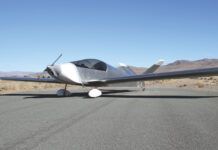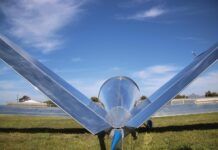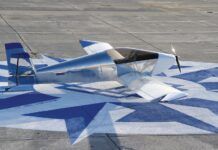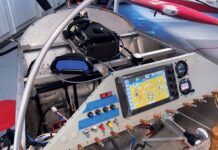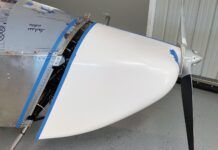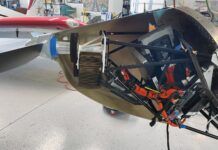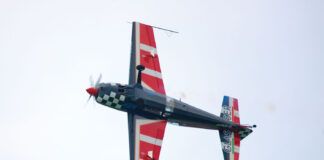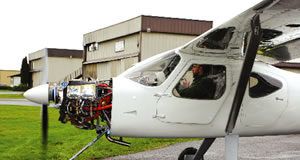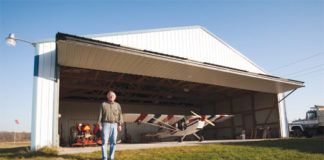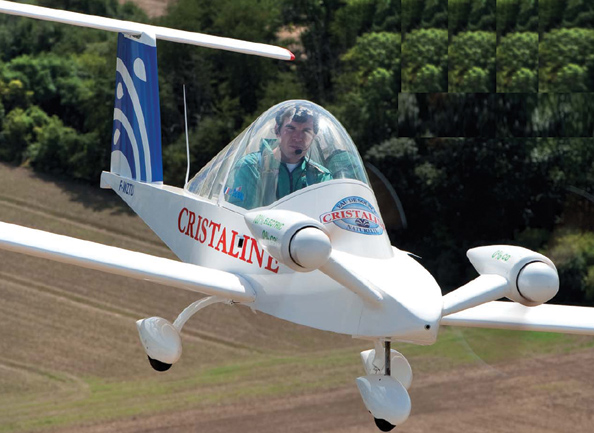
For how many five-year periods has the hydrogen car been five years away from commercial production? How many times have you seen a promising new battery that would run your Prius from Cleveland to Albuquerque before recharging? Promising new technology pops up almost daily, and web sites and magazines devoted to fanning the flames of hope keep those promises coming. But the idea of truly disruptive technology, that sparkly next best thing that will knock the antiquated current tech off its perch, remains elusive.
We actually see few immediate results of any new technology. The English longbow at the Battle of Agincourt punched holes through chain mail and steel armor, put an end to a generation of French nobility and quickly turned France over to new management. But most innovations don’t have that instant and profound an impact, literally or figuratively. The longbow was easily duplicated, however, and armorers had to quickly develop better shields and more effective counter weapons.
The British periodical The Automobile predicted in 1905 that its namesake new invention would surely rid London’s streets of the massive pollution left by hundreds of thousands of horses every day. Unintended consequences being what they are, automobiles did not stunningly, but slowly replace horses, and it was possible to have milk delivered by horse-drawn wagon in England into the 1970s (seen personally in a Northumberland village). The roads remained much the same, merely getting wider and smoother, and gas stations and garages replaced stables and blacksmith shops over decades. Likewise, steam didn’t immediately displace sail; electric lights didn’t immediately replace candles.
Similar timelines will probably follow as aviation enters its electric age. This article chronicles new and stunning developments that have the power to change flying profoundly. Their value is noteworthy, but the manner of their adoption by the general flying public will depend on several factors.
Modern electric aircraft date from the early 1970s, starting with Astro-Flight’s Bob and Roland Boucher’s first uses of rare-earth minerals in their small, powerful motors. Similar developments were being made in batteries, leading to lithium-based cells that are currently the lightest, most powerful for their weight units commercially available.
At this stage, with motors having reached formidable outputs and batteries teetering on the edge of being light enough to replace their high-energy-density fossil fuel competition, the practical electric airplane seems ever closer, but ever more elusive.
Despite several factors slowing things down, many innovations will bring about practical electric flight perhaps faster than the most optimistic (yours truly included) can now foresee.
High Power-to-Weight Ratio Electric Motors
Geoff Long helped develop a motor while at LaunchPoint Technologies that puts out 7 horsepower per pound. The 6-inch diameter, inch-and-a-half thick disk he showed at the fourth annual Electric Aircraft Symposium weighed about 1.4 pounds. Scaled up, this Halbach-array-based powerplant could efficiently convert volts to rpm and high torque. Long projects an 18-inch diameter motor weighing 15 kilograms (33 pounds) and being capable of putting out 150 brake horsepower at 3500 rpm and 97% efficiency.
Smaller units could be placed in landing gear brake disks to allow shorter takeoffs (imagine an extra 14 hp or more applied at the mainwheels to help overcome the drag of wet grass) and to bring the plane to a smoother, shorter more controlled landing while regenerating electricity back into the batteries.
Oxford University’s ISIS program, a school-based entrepreneurial enterprise, developed the yokeless segmented armature (YASA) motor. This device is already being installed in the Morgan
Lifecar, a high-performance, swoopy hybrid two-seater that will literally outshine anything else on the road. Oxford’s offspring cranks out more than 100 hp from a 24.2-pound pancake and has the potential to reach 150 hp.
Roman Susnik in Slovenia has created a range of 24-pound, 9-inch diameter motors that produce up to 50 kilowatts (67 hp) and can be run on a common shaft to double, triple or quadruple that output.
These are merely examples, and new developments ranging from paramotor powerplants to high-output hybrids spring forth regularly. Each pound of the old internal-combustion engine that can be offset by the lightness of these powerplants leaves room for the weightiest part of electric aircraft: batteries.
Battery Breakthroughs
According to Jaephil Cho of South Korea and Yi Cui of Stanford University, batteries have been “improving” about 10% per year for the last decade. According to that estimate, about every nine years, batteries will double in output for a given weight. Part of this comes from improved chemistries-nickel cadmium (NiCad) batteries are more energy dense than lead acid batteries; lithium ion and lithium polymer are superior in that respect to nickel-based cells.
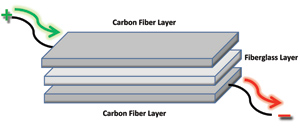
Dr. Emile Greenhalgh’s “magic sandwich” can be charged or discharged, with current flowing between the carbon layers. A conductive resin holds it all together. Volvo is working with Greenhalgh at Imperial College London to use the “battery” in hybrid cars.
Emerging laminar batteries, normally seen as “button” cells powering cell phones and other small devices, could be scaled up to provide energy storage for enough power output to run a small airplane, and could even be integrated into the total wiring system. Car manufacturers currently make once bulky wiring harnesses into layered thin sheets that run power windows, provide “cabling” for computers, radios and GPS receivers, and can fit flexibly into extremely thin confines. Batteries built on the same laminar approach could conform to airfoil and fuselage shapes, store and produce power for very low weight, and maybe become integral to the primary structure.
Nanotechnology
What if your airplane’s primary and secondary structures became the battery? What if they could collect solar energy on the airplane’s top surface and store it throughout the entirety of the airframe? Total integration of power source and airframe could happen if at least two recent discoveries become practical products. Imperial College London researchers found that carbon-fiber panels could store and release electricity with the flip of a switch. One small panel, after being charged, held the charge and was later able to light an LED. Although not as efficient as lithium batteries, the sheer size of panels in an airplane’s structure might allow enough energy for extended flight.
Consider another discovery that certain carbon fibers can act as solar panels to collect sunlight and store the energy in the aircraft structure. Add an electric motor and controller and have the Grand Unified Airplane. Think of “Wind Tunnel” columnist Barnaby Wainfan’s Facetmobile (see it at www.wainfan.com/facet.htm), with its large surface area and the possibility of “panelizing” its structure as envisioned by NASA’s Marc Moore and Wainfan.
Thin Film Solar Cells
Nanosolar prints a thin film of photovoltaic material on a foil substrate, and claims high cost efficiency. Ascent Solar deposits thin films on a plastic substrate and claims the highest efficiency thin film solar cells. Light, thin films will enable stretching battery range on an electric airplane and recharging while the plane sits between flights.
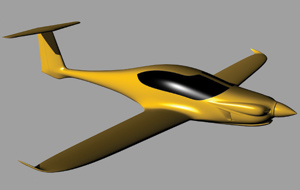
A Pipistrel hybrid, claiming 200 mph on 160-hp output. Test flying is slated to begin soon. (Courtesy Tine Tomazic/Pipistrel.)
Hybrids and KERS
No less than three companies, Tecnam, Pipistrel and Flight Design, are planning four-seat hybrids, according to the World Directory of Leisure Aircraft (2010-2011). At least two of them will use Rotax and Lycoming engines coupled with electric drives for extra power on takeoff. Flight Design is already testing a CT with a Rotax/electric motor parallel hybrid. Adding 40 hp to takeoff thrust, the motor will become a generator in flight, recharging its batteries and standing ready to provide limp-home mode if the primary reciprocating engine fails.
Such efforts are overshadowed by even more spectacular equipment and results in auto racing. Controversial adaptation of KERS (Kinetic Energy Recovery Systems) was curtailed in the 2010 Formula 1 season after teething problems in 2009 races. Such systems are be allowed in the 2011 season and will bear watching. The Williams F1 team, for instance, developed a mechanical flywheel reported at spinning up to 80,000 rpm, recapturing the energy generated during braking. That energy could be released to provide up to 6.67 seconds of added power for each lap. Ferrari, Renault and BMW have also developed electrical KERS units. Recently, Honda released a report on its system tested during the 2009 system. The 15.2-pound KERS motor was able to generate 60 kilowatts (80.4 hp), or 5.28 hp per pound. Such lightweight, high-output components will certainly be of interest in green aviation’s future. Porsche’s 918 Spyder hybrid shows the extreme possibilities of such systems, lapping the North side of the Nurburgring in 7:30 (faster than a Carrera), going from 0 to 62 mph in 3.2 seconds, and topping 94 mpg in probably more moderate driving. Alas, its extreme price restricts it to a few fortunate enthusiasts.
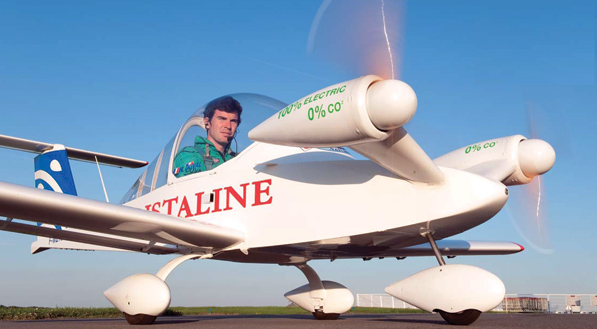
E-Props’ 83cm (32.67 inch) laminated beech propellers have been specifically designed for high-speed flight. (Courtesy Anne Lavrand/APAME/E-Props.)
Simple and Homebuilt Electric Airplanes
Anne Lavrand of APAME, a French organization dedicated to the Promotion of Electrical Flying Machines (rough translation), garnered points for helping create a Souricette (little mouse) powered by a Lynch brushed motor. This ultralight is normally powered by anything from a paramotor two-stroke engine to a Briggs & Stratton V-twin conversion, so the small mass of the electric motor and controller allowed adequate batteries for a 48-minute first flight in 2008. Later, the same team converted an Alatus motorglider to electric power. The clean design allowed a smaller battery pack and a 1 hour and 7 minute outing. Last September, Electravia used two Lynch motors to break the world electric aircraft speed record at 162 mph, nudging the redline on the Colomban Cri-Cri. News of its upcoming ultralight and two-seat flying wing affordable electric aircraft brought down the Gizmag web site briefly, indicating a tremendous interest in the wannabe electric flier community.
Another French group built airplanes based on Mignet’s Flying Flea formula, but using a commercially available aluminum ladder for the fuselage. The ladder company filed a motion to prevent its use in aircraft, so APEV, the Association for the Promotion of Flying Ladders (very rough translation) reverted to commercially available aluminum angle riveted and bolted together for an equivalent ladder-like fuselage frame. They also designed a Santos-Dumont Demoiselle type craft using similar techniques. Both airplanes are powered by two-stroke Rotaxes, which were subsequently replaced by Lynch-type motors on the slightly modified electric versions. A Demoichellec (punning combination of Demoiselle, ladder and electric) was constructed during the Green Aviation Show at Orly Airport, Paris, in three days.
Many are joining the NASA Green Flight Challenge, but the Feuling Green Flight Challenger team’s accomplishment is noteworthy for being affordable. With its new airframe entirely of carbon composite, the airplane bears an unmistakable resemblance to the 1970s Quickie. Gene Sheehan calculates the cost for the airframe, motor, controller and battery at around $25,000. This is for an airplane that will have to achieve the 200-mile range and 100-mph average (including takeoff and landing) for the closed course, and still be able to take off and land within 2000 feet over a 50-foot barrier.
The Electric Cessna
We end this exploration of things that just might disrupt current aeronautical practice with George Bye’s electric Cessna 172. Powered by a UQM motor and energized by Panacis battery packs, the 172 itself is not a ground-breaking design, having been in continuous production through many models since 1956. But a base of 43,000 airframes that may support Bye’s conversion, with eventual use of Ascent solar cells and wingtip vortex collectors, could make this electric flier a common sight at airports around the world in coming years. Whether Lycoming, Continental and Rotax can find a way to keep their fossil-fuel-burning engines viable when alternatives become economically available remains to be seen. That in itself could be the most disruptive aspect of the coming changes in clean aviation.


